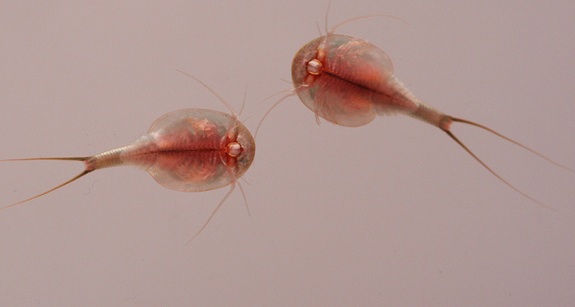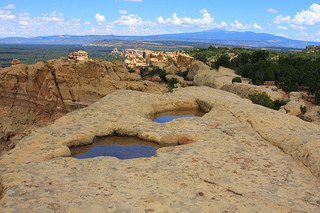Sea Monkeys, Ferns and Frozen Frogs: Nature’s Very Own Resurrecting Organisms
As Easter draws near, we celebrate creatures that seemingly die and then come back to life
![]()

Tadpole shrimp eggs can remain dormant for years, then burst into life when elusive desert rains arrive. Photo by Flickr user theloushe
As Easter draws near, we begin to notice signs of nature’s very own annual resurrection event. Warming weather begins “breeding lilacs out of the dead land,” as T.S. Elliot noted, and “stirring dull roots with spring rain.” Where a black and white wintery landscape just stood, now technicolor crocus buds peak through the earth and green shoots brighten up the azalea bushes.
Aside from this grand show of rebirth, however, nature offers several cases of even more overtly stunning resurrections. From frozen animals jumping back into action during spring thaws to life blooming from seemingly desolate desert sands, these creatures put a new spin on nature’s capacity for revival.
Resurrection fern

A resurrection fern, before and after watering. Photo by Flickr user Gardening in a Minute
As its name suggests, during a drought the resurrection fern shrivels up and appears dead, but with a little water the plant will burst back into vibrant life. It can morph from a crackled, desiccated brown into a lush, vibrant green in just 24 hours.
The fern doesn’t actually die, but it can lose up to 97 percent of its water content during an extreme dry spell. In comparison, other plants will usually crumble into dust if they lose more than 10 percent of their water content. Resurrection ferns achieve this feat by synthesizing proteins called dehydrins, which allow their cell walls to fold and reverse back to juicy fullness later.
Resurrection ferns are found as far north as New York and as far west as Texas. The ferns needs another plant to cling to in order to grow, and in the south it’s often found dramatically blanketing oak trees. A fallen oak branch covered in resurrection ferns are common features in southern gardens, though the ferns have also turned up in more uncanny locales: in 1997, astronauts took resurrection fern specimens onto the Space Shuttle Discovery to study how the plant resurrects in zero gravity. As investigators write (PDF), the fern “proved to be a hardy space traveler and exhibited regeneration patterns unaltered by its orbital adventure.” This earned it the title of “first fern in space.”
Brine shrimp, clam shrimp and tadpole shrimp
In the deserts of the western U.S., from seemingly life-barren rocks and sands, life blooms by just adding a little rain water. So-called ephemeral pools or “potholes” form tiny ecosystems ranging from just a few millimeters across to several meters deep. The ponds can reach up to 140 degrees Fahrenheit in the summer sun or drop below freezing during winter nights. They can evaporate nearly as quickly as they appeared, or linger on for days or weeks. As such, the animals that live there all have special adaptations for allowing them to thrive in these extreme conditions.

Ephemeral desert ponds in New Mexico. Photo: J. N. Stuart
Some of the potholes’ most captivating critters include brine shrimp (of sea monkey fame!), clam shrimp and tadpole shrimp. These crustaceans practice a peculiar form of drought tolerance: In a process known as cryptobiosis, they can lose up to 92 percent of their body water, then pop back into fully-functional action within an hour of a new rain’s arrival. To do this, the tiny animals keep their neural command center hydrated but use sugar molecules instead of water to keep the rest of their cells intact throughout the drought. Like resurrection ferns, brine shrimp, too, have been taken into space–they were successfully hatched even after being carried outside of the spacecraft.
Most of these animals only live for about ten days, allowing them to complete their entire life cycle (hopefully) before their pool dries up. Their dried eggs are triggered to hatch not only when they’re hydrated again but also when oxygen content, temperature, salinity and other factors are just right. Some researchers, such as this zoologist quoted in a 1955 newspaper article, think that the eggs can remain dormant for several centuries and still hatch when conditions are right.
Wood frogs
Some amphibians undergo their own sort of extreme hibernation in order to survive freezing winter temperatures. This suspended animation-like state allows them to slow down or stop their life processes–including breathing and heartbeat–just to the brink of death, but not quite. Wood frogs, for example, may encounter freezing conditions on the forest floor in winter. Their bodies may contain 50 to 60 percent ice, their breathing completely stops and their heartbeat is undetectable. They may stay like this for days, or even weeks.
They achieve this through a specially evolved biological trick. When the frogs encounter the first signs of freezing, their bodies pull moisture away from its central organs, padding them in a layer of water which then turns into ice. Before it freezes, the frog also floods its circulatory system with sugar molecules, which act as an antifreeze. When conditions warm up again, they can make a complete recovery within a day, which researchers call “spontaneous resumption of function.” Here, Robert Krulwich explains the process:
<object width="600" height="450" classid="clsid:d27cdb6e-ae6d-11cf-96b8-444553540000" codebase="http://download.macromedia.com/pub/shockwave/cabs/flash/swflash.cab#version=6,0,40,0"><param name="allowFullScreen" value="true"/><param name="allowscriptaccess" value="always"/><param name="src" value="http://www.youtube.com/v/UuhEHNey37Q?version=3&hl=en_US"/><param name="allowfullscreen" value="true"/><embed width="600" height="450" type="application/x-shockwave-flash" src="http://www.youtube.com/v/UuhEHNey37Q?version=3&hl=en_US" allowFullScreen="true" allowscriptaccess="always" allowfullscreen="true"/></object>
As seen through these examples, some creatures really do come back from the brink of death to thrive!
/https://tf-cmsv2-smithsonianmag-media.s3.amazonaws.com/accounts/headshot/Rachel-Nuwer-240.jpg)
/https://tf-cmsv2-smithsonianmag-media.s3.amazonaws.com/accounts/headshot/Rachel-Nuwer-240.jpg)